CareerBridge
Self-learning platform
CareerBridge is a self-learning platform that helps people advance their careers by providing guidance to achieve specific goals, tracking progress, and offering credibility when seeking employment or advancement opportunities.
Role: Product design
- Product Strategy
- User research
- Visual design & interaction
- Prototyping and testing
DATE: Jan 2022- June 2022
Background
The increasing availability of Massive Online Courses, coding bootcamps, and startup incubator programs has made it clear that education is becoming more accessible and empowering individuals to forge their own career paths.
I was the sole product designer
I started working with careerbridge as a product designer when it was just an idea. I led the product strategy, User Research, Interaction, visual design, prototyping, and Testing. I feel fortunate to have been a part of Careerbridge and have experienced a lot of career growth. Here are some of the highlights of what I accomplished:
I transformed an idea into a product: Even though the product is still in the works and has not yet been released, it has been exciting to see its growth and progress.
I contributed to the product development: I conducted research and contributed to the product’s growth.
Understanding the problem
As a college student, I knew firsthand how difficult it could be to find a job without any prior experience. To confirm this experience with others, I organized focus group sessions at a nearby coffee shop with 5 random university students and graduates who also struggled with finding employment.
I interviewed them one by one to learn more about his experience. we chose to focus on the software industry particularly software engineering, as is a rapidly growing field that requires ongoing learning and staying up to date with current trends.

After Listening to these students, I discovered the top frustrations:
- Unrealistic expectations set by employers: Students can become demotivated when they see that they do not meet the requirements for entry-level jobs, such as having a certain number of years of experience. This can create a Catch-22 situation where students cannot gain the necessary experience because they have not been able to get a job.
- Knowledge and industry gap: While universities provide education on various subjects, there is often a discrepancy between what is taught in academia and what is expected by employers in the workforce. This can leave students feeling inadequately prepared for their careers. While online courses, bootcamps, and self-education providers may help to bridge this gap, they do not fully address the issue.
- The attitude of recruiters and employers: There are some recruiters in the technical field who do not have the expertise or competency to evaluate a candidate's technical skills. Often, they rely on keyword searches and the hiring process becomes more about matching certain keywords rather than assessing the candidate's actual abilities.
- Lack of a streamlined recruitment process: The lack of standardization in job application processes within the software industry makes it a time-consuming task to apply to different companies, as each company has its own unique assessment processes and requirements.
- Cultural fit and gender bias: There was a perception among some non-native speaking students that they experienced discrimination based on their cultural background and difficulty with the language. In addition, there was a belief among many that employers often chose female candidates to meet diversity quotas, particularly in the software industry.
User Personas
According to our findings, I identified three groups of users that our product aimed to help. I determined that Persona 1 had the most pressing needs and could be reached through educational institutions such as universities, bootcamps, and organizations like General Assembly and CoderAcademy. Therefore, I chose to focus on Persona 1.
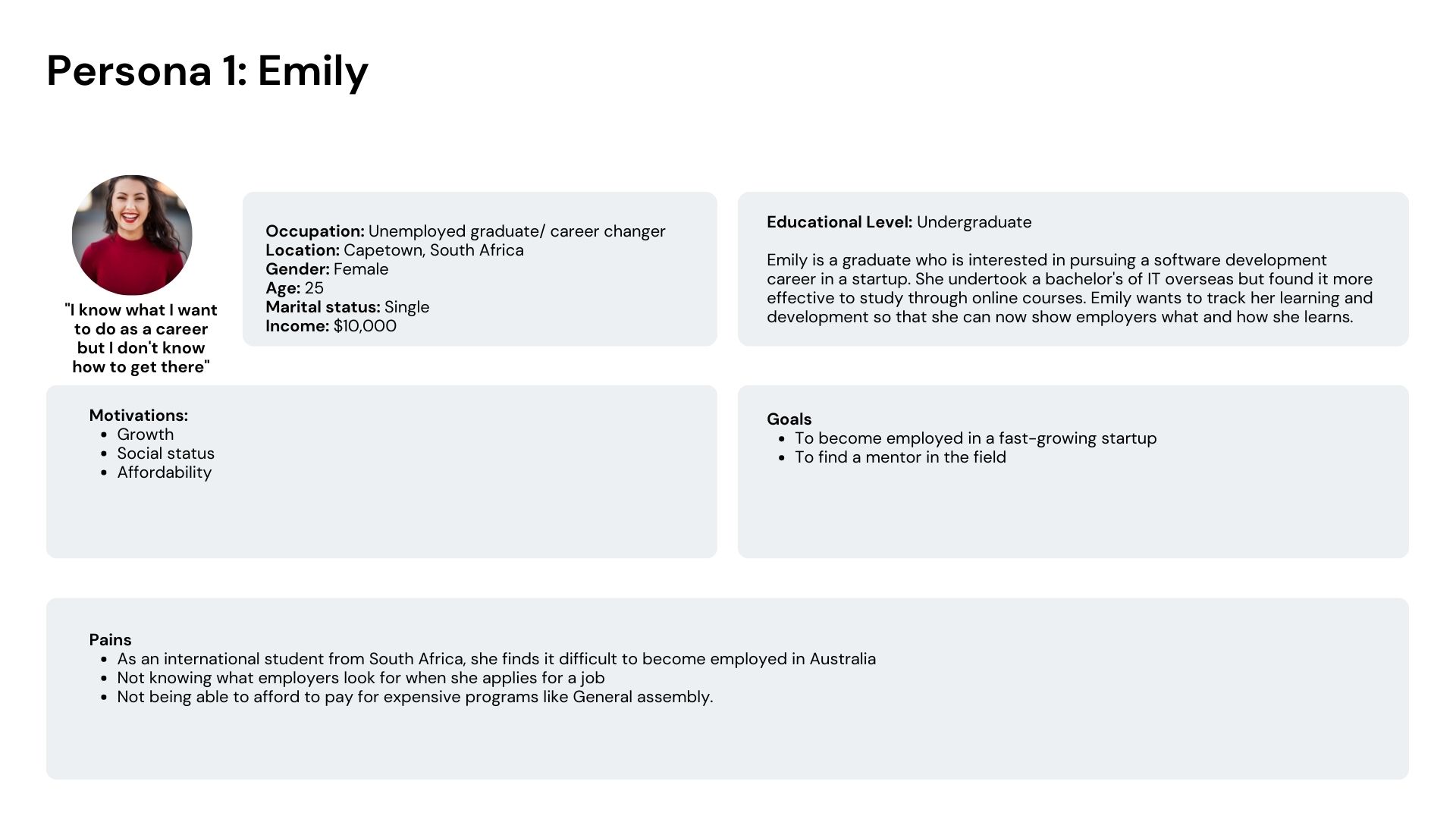

Defining the problem statement
After completing the research, I collaborated with my team to identify the issue that needed to be addressed.
Problem statement
Professionals who are focused on advancing their careers often feel frustrated because they do not have a clear understanding of the skills they need to improve upon, the steps they need to take to achieve their goals, and how well they are progressing toward those goals.

The product Vision
We wanted to position our product as the top career management platform with a focus on three main areas:
- Career goal management:We aim to assist individuals in realizing their potential for achieving their career objectives by offering them the opportunity to monitor their learning and progress over time.
- Career development advice:We want to give individuals guidance on how to reach their objectives through various learning resources such as courses, books, events, podcasts, blogs, internships, etc.
- Career experience validation:we want to become the top provider of accreditation for all types of learning and eventually replace traditional resumes, which do not effectively demonstrate an individual's skills, potential, and goals.
Defining the MVP
I worked with the team through a series of workshops and sketching sessions to create a plan for the user experience and develop a storyboard to represent the minimum viable product.
We identified the following key feature:
- Goal definition: Users should be able to set a career goal and specify the level they wish to reach within that profession.
- List of recommendations: Get a list of activities, such as classes, events, and online resources like blogs and podcasts, that can help you improve and strengthen any areas where you may be lacking knowledge or skills.
- Connecting with providers: Create a list of your past activities by selecting from a variety of sources like Codecademy, Coursera, Khanacademy, Github, Stack Overflow, etc. This will allow your activities to be automatically updated, eliminating the need to manually keep track of everything you have done.
- Tracking of development:Examine your progress over a period of time to determine how close you are to achieving your goal.
It is important to mention that there were technical limitations that had to be considered while developing the learning machine algorithm for the recommendations page. As a result, a temporary solution was proposed, which involved creating a list of activities manually based on profession, specialization, and level.

Designs
User testing was an iterative process that was conducted at every milestone of the project to identify the biggest pain points in the current version. Once feedback was gathered, I would revisit the prototype and test it again.
I wanted to design a user interface that is simple, uncluttered, and fresh, and that conveys a sense of trustworthiness and forward-thinking for people who are looking to the future.
Landing Page
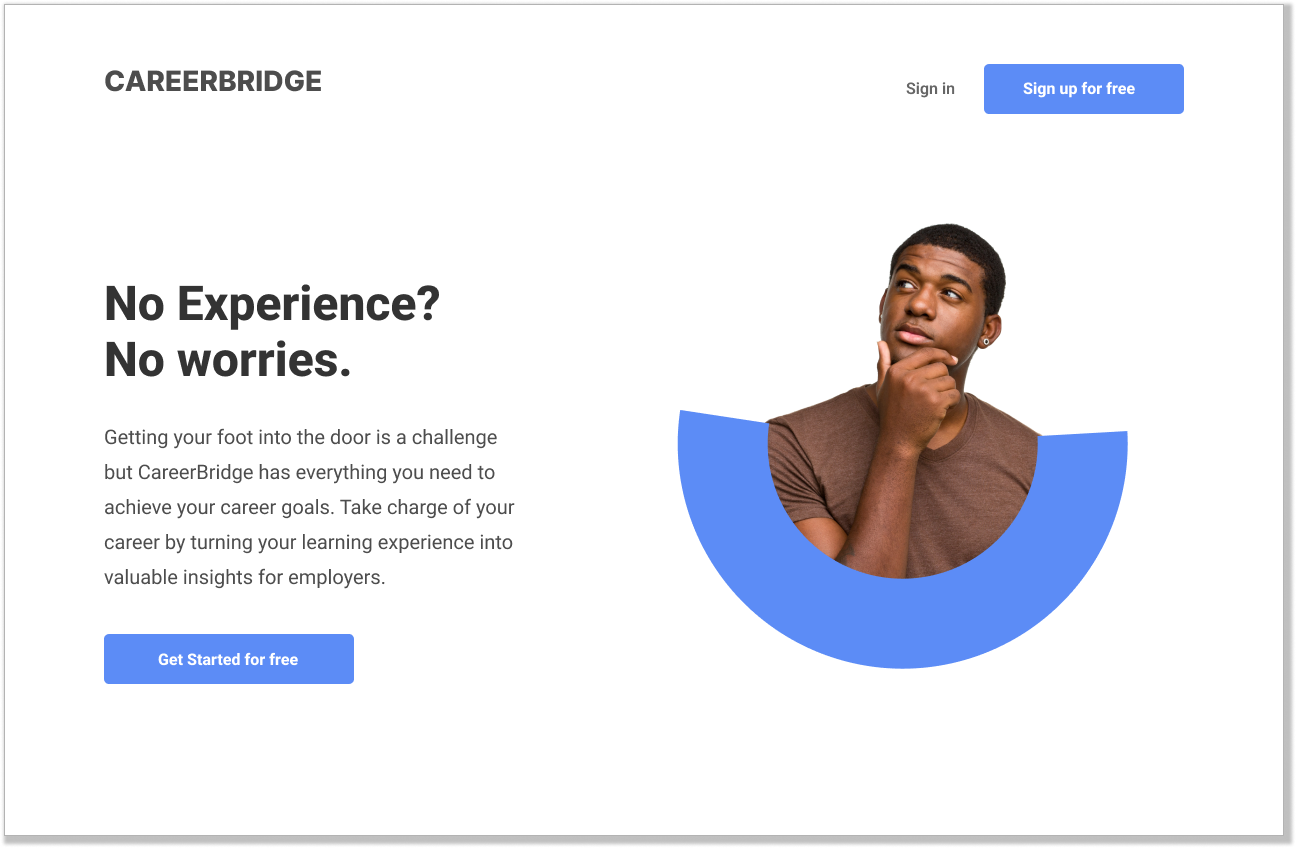
Sign up Page
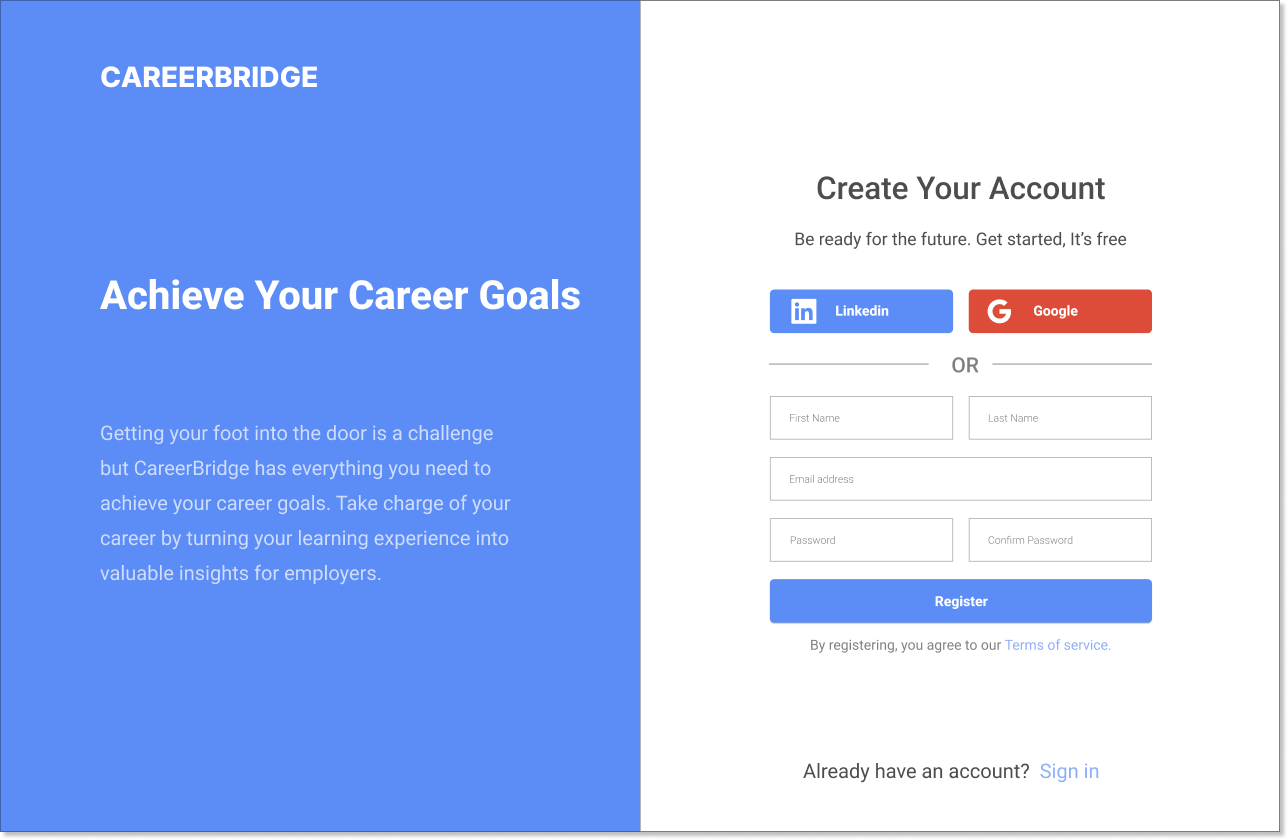
Onboarding Flow

Browse page
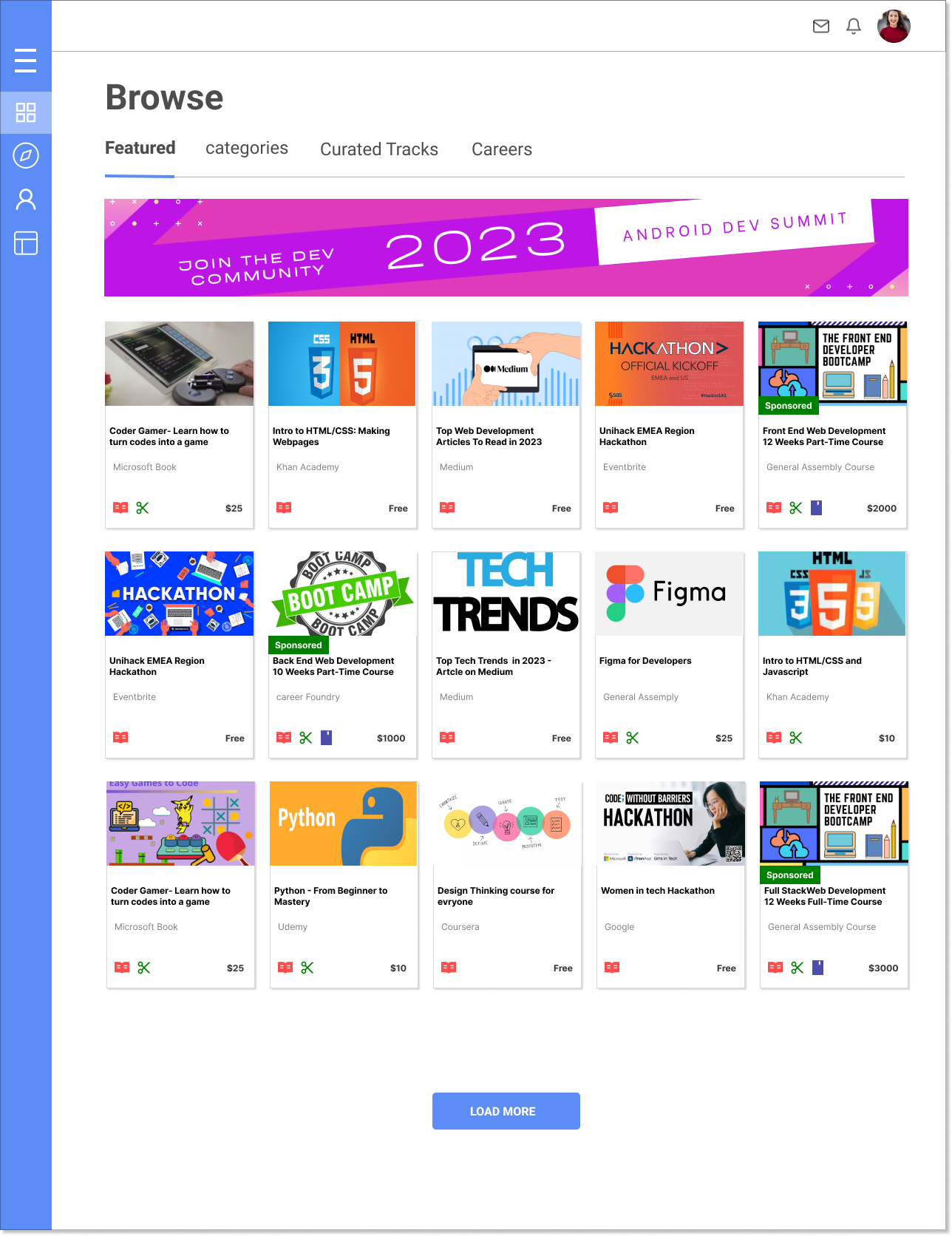
Dashboard

Profile

I created a site map to illustrate the platform's overall site architecture and help engineers understand it as part of my vision for the future. The main areas were segmented as follows:
- Stage 0 - Onboarding:Set a goal, determine a specific objective and identify the level of advancement you wish to achieve in your professional development.
- Stage 1 - Profile and Account Setup:Set up your basic account and view a profile, skills, and progress.
- Stage 2 - Discover: Receive a plan of recommendations (e.g: courses, books, events, articles, etc.) to work towards your goal.
- Stage 3 - Networks:Build communities and connect with other like-minded individuals working towards the same goal as you.
- Stage 4 - Home: See an overview of your learning, recommendations, upcoming events, and job notifications.
- Stage 5 - Jobs:Get matched to jobs from companies based on your skills and goals.
N. B: Networks and Jobs pages will be built after the platform will be running smoothly.
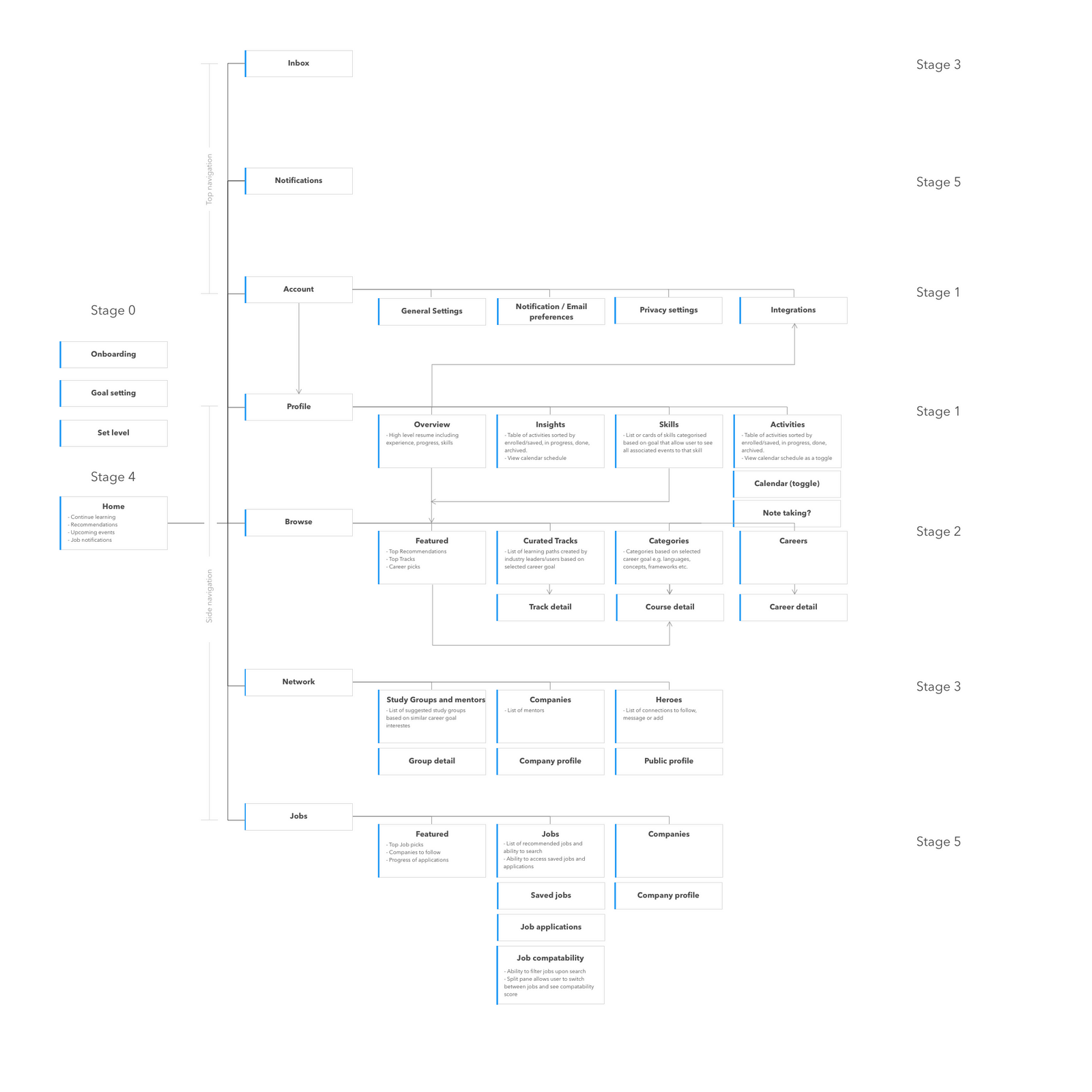
Results and takeaways
Some key takeaways from this project are:
- Focus on the problem:Ultimately, it is the issues and problems faced by your users that you should be focusing on, as it is easy to forget this when you are busy with daily tasks. It is essential to keep this in mind as you work.
- Focus on building an MVP:It is crucial to prioritize the features that will provide the most benefit for your users, as you have limited time and energy to invest, especially when working a full-time job.
- Don’t worry too much about the detail: Earlier in the process of designing my product, I focused too much on the appearance of the user interface. However, after reviewing the user experience and how people would navigate through the product, I realized that prioritizing the user experience was more important than the visual appearance.
